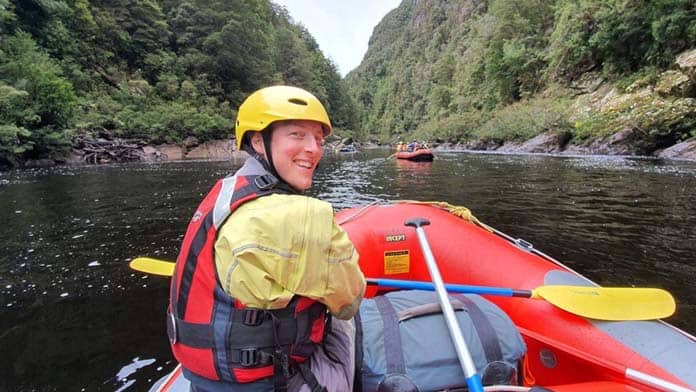Franklin is a beautiful film about the seven-year campaign to save Tasmania’s World Heritage-listed Franklin River from the construction of a hydroelectric dam.
The filmfollows the journey of Oliver Cassidy as he retraces the steps of his father, who rafted down the Franklin in the early 1980s on a 14-day paddle intended to garner public support for preserving the river and to join the protesters at the Franklin blockade.
Franklin shows archival and new footage, including shots of areas that would have gone underwater had the dam been constructed, such as Rock Island Bend and Kutikina cave—a sacred site for the Indigenous palawa containing evidence of the most southerly human occupation during the last ice age.
The campaign to save the Franklin was successful. However, it relied on a strategy of media advertising designed to influence a federal election campaign rather than looking to win rank-and-file union support.
The proposal for the Franklin dam came from the Hydro Electric Commission (HEC), a Tasmanian government statutory authority.
By the 1970s the HEC had dammed all the major river systems in the state except for the Franklin. During this time the HEC was the state’s largest employer, running 36 dams and 26 power stations.
The dam was intended to provide cheap electricity and thus lure industry into the state. It was supported by the Tasmanian Labor government and sections of the population looking to the project for jobs.
Resisting the dam thing
After the failure to stop the damming of Lake Pedder, environmentalists were more determined than ever to protect the southwestern wilderness of Tasmania.
In 1980 there was a 14,000 strong anti-dam march in Melbourne and a 10,000 strong anti-dam march in Hobart.
In response, Tasmanian Labor offered to make the Franklin a national park and proposed a smaller dam on the Gordon River.
The issue went to a referendum in 1981. But Tasmanians could choose only between the HEC’s original dam or the smaller dam—the “no dam” option was not on offer.
Despite this, 45 per cent voted informally, with most writing “no dams” on the ballot, and 47 per cent of voters favouring the HEC scheme. The state was effectively evenly divided.
In 1982 a Liberal state government headed by Robin Gray was elected and dam building continued. Protesters occupied Warners Landing on the remote Gordon River near where it meets the Franklin. Their camp drew 2500 people between December 1982 and March 1983.
Protesters undertook non-violence training and exercises to prepare to stop machines and face arrest.
A prominent strategy was to “fill up the jails”. The logic was that if enough people were arrested, the cost would become too much for the state, stopping the project.
The police operation against the protesters cost $37,000 a day and 1217 people were arrested, including future Senator Bob Brown. But despite this, the state Liberals pushed on.
Saving the damned
The campaign now looked to the federal government to stop the dam.
The Wilderness Society (TWS) raised nearly a million dollars, including from sympathetic businessmen like Dick Smith.
Using this money, TWS launched a media campaign in the lead up to the 1983 federal election, taking out full-page ads in national newspapers with a photo of Rock Island Bend along with the caption “Could you vote for a party that will destroy this?”
Federal Labor leader Bob Hawke promised to stop the dam if elected and won the election in a landslide.
One of his first moves was to stop construction of the dam.
Gray’s Liberal state government took the federal government to the High Court to try to rule Hawke’s decision unconstitutional, but lost. The Franklin was saved.
It was a great outcome but compared to other major environmental campaigns, the Franklin campaign was striking for its lack of union involvement.
Some unions supported the dam. And there was no sustained effort from no-dam protesters to appeal to rank-and-file workers for support.
It is true no-dam protesters chanted at rallies “jobs not dams” and submitted alternative proposals for energy and job creation to the HEC. But the orientation of the movement was always towards appealing to parliament and the courts for environmental protection, not to the power of the organised working class.
The protest camp and marches in the streets raised awareness but alone were not enough to stop the dam.
In contrast, the anti-uranium campaign of the 1970s involved a combination of direct action, protests and union black bans that resulted in the export of uranium being almost impossible for a time.
Federal Labor today is backing at least 114 new fossil fuel projects and a woeful emissions reduction target of 43 per cent by 2030.
Workers’ involvement in the climate movement today is crucial. Fossil fuels are more deeply structured into capitalism than dams, meaning a much more powerful movement is required to win the climate action we need.
It is only through strike action—workers refusing to allow society and the economy to function until their demands are met—that the government and capitalists can be forced to build 100 per cent publicly owned renewable energy, phase out coal and gas, and ensure a just transition for fossil fuel workers.
The climate movement needs the power of workers to succeed.
By Luke Ottavi
Franklin, directed by Kasimir Burgess, see film website here for screening details






